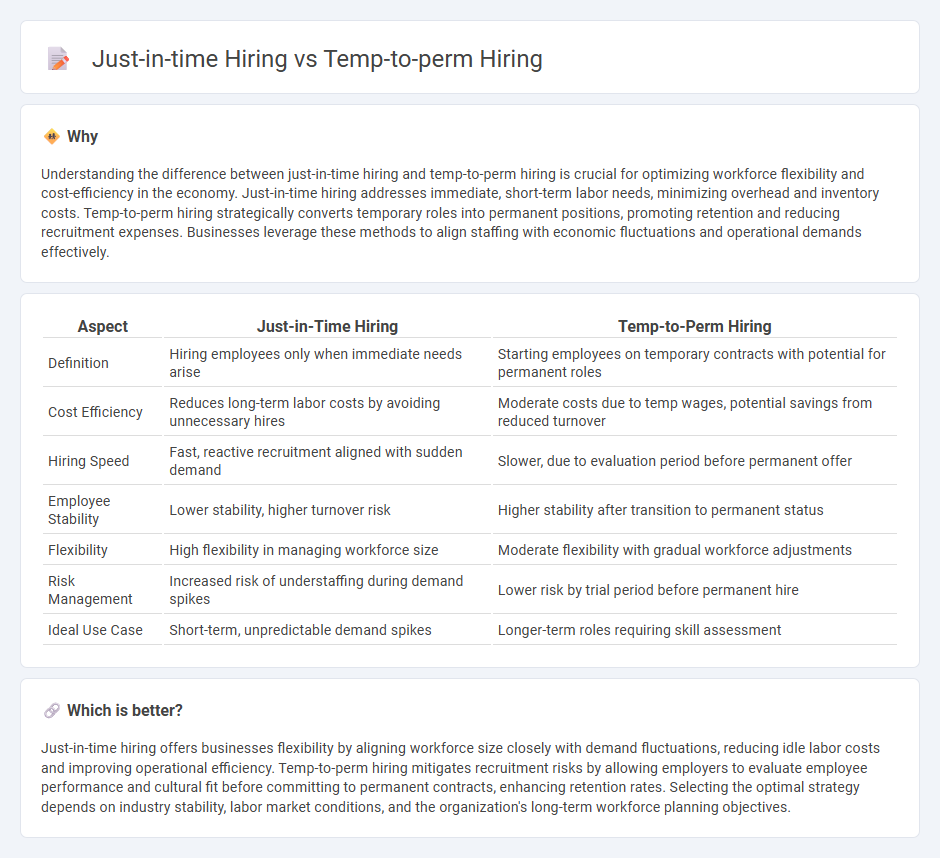
Just-in-time hiring minimizes labor costs by aligning workforce needs precisely with demand fluctuations, reducing idle employee expenses. Temp-to-perm hiring offers companies the flexibility to evaluate candidate performance before committing to permanent employment, thereby lowering turnover risks. Discover how each strategy impacts organizational efficiency and workforce stability.
Why it is important
Understanding the difference between just-in-time hiring and temp-to-perm hiring is crucial for optimizing workforce flexibility and cost-efficiency in the economy. Just-in-time hiring addresses immediate, short-term labor needs, minimizing overhead and inventory costs. Temp-to-perm hiring strategically converts temporary roles into permanent positions, promoting retention and reducing recruitment expenses. Businesses leverage these methods to align staffing with economic fluctuations and operational demands effectively.
Comparison Table
| Aspect | Just-in-Time Hiring | Temp-to-Perm Hiring |
|---|---|---|
| Definition | Hiring employees only when immediate needs arise | Starting employees on temporary contracts with potential for permanent roles |
| Cost Efficiency | Reduces long-term labor costs by avoiding unnecessary hires | Moderate costs due to temp wages, potential savings from reduced turnover |
| Hiring Speed | Fast, reactive recruitment aligned with sudden demand | Slower, due to evaluation period before permanent offer |
| Employee Stability | Lower stability, higher turnover risk | Higher stability after transition to permanent status |
| Flexibility | High flexibility in managing workforce size | Moderate flexibility with gradual workforce adjustments |
| Risk Management | Increased risk of understaffing during demand spikes | Lower risk by trial period before permanent hire |
| Ideal Use Case | Short-term, unpredictable demand spikes | Longer-term roles requiring skill assessment |
Which is better?
Just-in-time hiring offers businesses flexibility by aligning workforce size closely with demand fluctuations, reducing idle labor costs and improving operational efficiency. Temp-to-perm hiring mitigates recruitment risks by allowing employers to evaluate employee performance and cultural fit before committing to permanent contracts, enhancing retention rates. Selecting the optimal strategy depends on industry stability, labor market conditions, and the organization's long-term workforce planning objectives.
Connection
Just-in-time hiring and temp-to-perm hiring strategies optimize workforce flexibility by aligning employee acquisition closely with real-time business needs, reducing labor costs and minimizing idle resources. Just-in-time hiring enables companies to rapidly onboard temporary workers, who can then transition into permanent roles through temp-to-perm agreements based on performance and demand. This synergy enhances operational agility, improves talent retention, and supports dynamic economic environments by balancing labor supply with fluctuating market conditions.
Key Terms
Labor Flexibility
Temp-to-perm hiring enhances labor flexibility by allowing employers to evaluate workers during a trial period before offering permanent positions, reducing long-term hiring risks and optimizing workforce adaptability. Just-in-time hiring prioritizes rapid staffing responses to immediate labor demands, enabling companies to scale their workforce efficiently without long-term commitments. Explore how these strategies impact operational agility and workforce management to determine the best fit for your business needs.
Talent Pipeline
Temp-to-perm hiring builds a robust talent pipeline by initially engaging candidates on temporary contracts, allowing employers to evaluate skills and cultural fit before offering permanent positions. Just-in-time hiring focuses on immediate staffing needs, often resulting in shorter talent pipeline development and less opportunity for thorough candidate assessment. Explore our insights to understand which strategy best strengthens your talent pipeline for scalable growth.
Workforce Optimization
Temp-to-perm hiring offers businesses flexibility by allowing evaluation of candidates' performance before permanent placement, reducing long-term hiring risks and associated costs. Just-in-time hiring emphasizes rapid onboarding to meet immediate labor demands, optimizing workforce scalability and minimizing idle human resources. Explore how combining these strategies can maximize workforce optimization and operational efficiency.
Source and External Links
Pros and Cons of Temp-to-Perm Hiring - Activated Scale - Temp-to-perm hiring is a staffing strategy allowing companies to assess temporary workers' skills and culture fit during a 3 to 6 months trial period before offering permanent roles, providing valuable insights but also posing challenges like job security concerns and training needs.
The Pros and Cons of Temp-to-Perm Positions - Upwork - This hiring approach reduces financial risk and speeds up recruitment by using staffing agencies' pre-screened candidates, offering flexibility and access to skilled workers, while helping employers evaluate performance before permanent commitment.
Your Complete Guide To Temp-to-Perm Jobs | Indeed.com - Temp-to-perm jobs start as temporary roles that may transition into permanent positions, enabling candidates to demonstrate their abilities and fit with the company culture before securing a long-term job.
 dowidth.com
dowidth.com